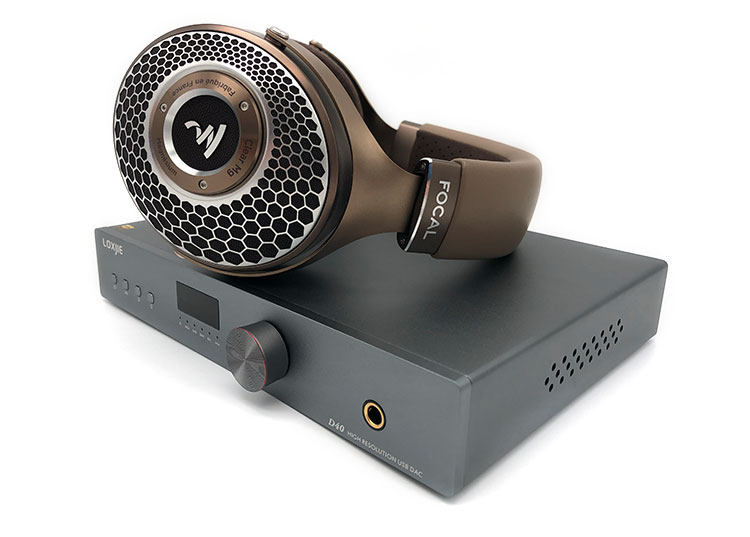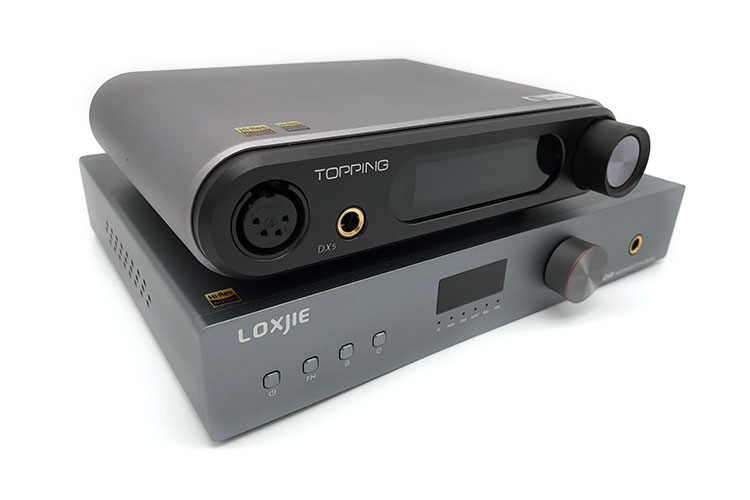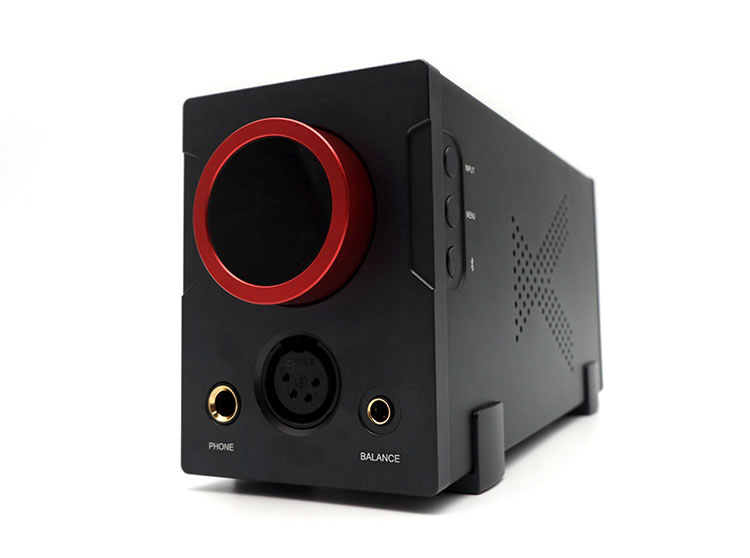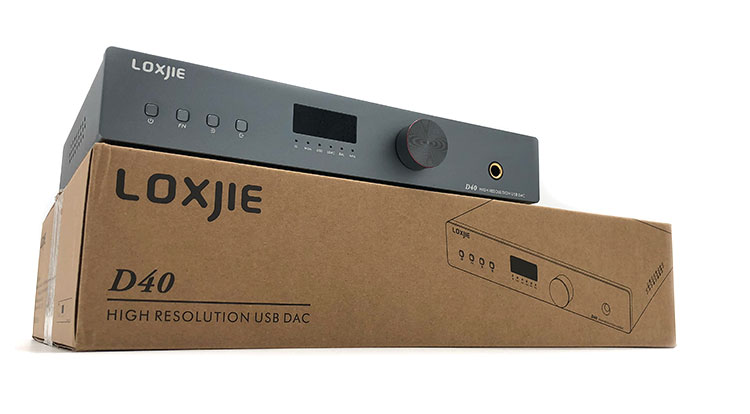Select Comparisons
Topping DX5
$449
Technical
Two ESS ES9068AS DAC chips can be found inside the DX5 for separate channel decoding, similar to the implementation in the D40. Music playback is equally capable as both use the same XMOS XU216 USB processor.
Boasting full MQA decoding in all its digital inputs, except Bluetooth of course, the DX5 is one-upped by the D40 offering master quality playback in its AES/EBU input as well. The D40 is also outfitted with an additional I²S input opening it to compatible sources.
The juice of the DX5 comes from Topping’s own NFCA circuit rated at 1.8W for 32-ohm loads, which is a more specialized approach than using off-the-shelf parts.
Design
The launch of the DX5 is important for Topping as it is the first device to introduce their friendlier approach to designing equipment. And next to the D40, their efforts highlight how simple and boxy the features of the bigger DAC/Amp are.
With a continuously flowing chassis following the perimeter of the XLR and volume knob, the body of the DX5 infuses a sense of cohesion and tightness adding to how the features on the face of the unit are right next to each other. Having a two-tone colorway also gives a more animated presence to the eyes.
While it is also packed with a remote, the DX5 only has the volume wheel as the only other way to interact with the machine. It does however come with a bigger and more informative display that is set slightly dimmer by default.
Performance
Closely keeping the same tonal character, the mid-bass of the DX5 is more elevated helping details harder to detect in the D40 to come across and with a much-needed texture. Yet, the softer and pushed-back nature of the D40 is better at producing a roomier experience.
For midrange, it is surprising to hear that the DX5 has a warmer touch on female vocals and fuller sounding strings than the D40. The characteristics of piano and fading notes are well emphasized for easier detail pickup.
Putting on some jazz, saxophone and chimes seem bigger in the DX5, although the sharper tuning may turn off some listeners especially if matched poorly. The D40 is a better match for those looking for crisp treble without fatiguing qualities.
The stage width of the DX5, while already wide on its own, is a few steps closer compared. Although, the DX5 offers excellent dynamics, especially for harder-to-drive gears.
xDuoo XA-10
$479
Technical
On decoding duty for the XA-10 are two AKM AK4493 chips for a fully balanced circuit design as proudly manifested by the presence of two balanced connections in front and one at the back through a mix of XLR and 4.4mm sockets.
Only the USB input supports MQA, but it is equally future-proofed in PCM and DSD playback. While the digital input of the XA-10 might be limited in comparison, it somehow manages to squeeze in a pair of RCA inputs accepting analog signals from other DACs or pre-amp if the need arises.
Its amplifier section is fitted with class-A buffer transistors and OPA1612 op-amps putting out a substantial 4W balanced and 3W single-ended power on a 32-ohm load. While using the same set of op-amps, xDuoo was able to put more emphasis on its amp section making it capable of handling less-sensitive loads with ease.
Design
Having a taller than it is wide chassis, the XA-10 uses less desk space yet seems to be the harder to ignore unit of the two. Its face is symmetrically arranged with three outputs down below and a rich red ring by the center for volume adjustments.
Both use air vents to let the unit breathe but xDuoo has stylized theirs into an ‘X’ while Loxjie kept the D40’s punched holes more straightforward.
A distinctive green-lit OLED screen provides all the user feedback regarding the status of the machine with buttons for access placed on the right side of the unit and not the front. Depending on where you place the XA-10 on your desk, the buttons being placed on one side may be in hidden view.
Performance
With an initial attack followed by gentle rolling sub-bass, XA-10 has an extra kick in the low-end which could be engaging depending on the song. Although opposite to how the D40 carries a smoother character, bass on the XA-10 can be a bit too etched at times.
If a soulful and gripping rendition of the midrange is what you’re looking for, the XA-10 has a warmer midrange capable of replicating vibrato with finer delicacy. The D40 is much more honest in this regard, as piano keys sound heavier and sweeter on the XA-10.
Where the XA-10 somehow loses energy is in the treble region making instruments harder to place. Violin misses its engrossing character appearing leaner as a result.
With an emphasis on the midrange and lack of sparkle in the treble, the XA-10 still cast a pretty wide stage, only appearing intimate on vocal-heavy or acoustic music.
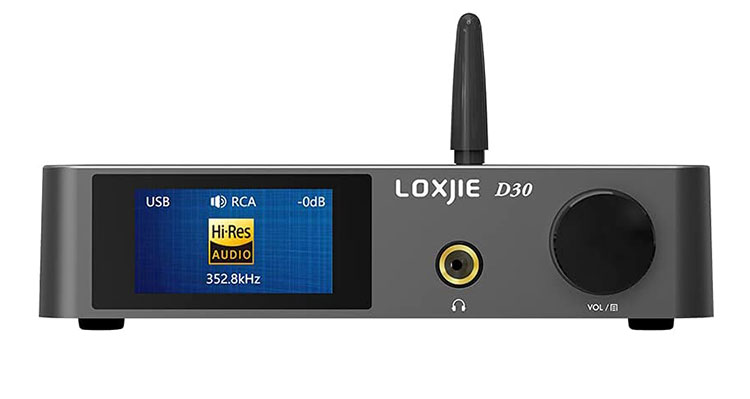
Loxjie D30
$259.99
Technical
Positioned for the slightly more budget-conscious, D30 is a single-ended only DAC/AMP combo with simpler internals. While this may be the case, it shares some components with the D40 right from its use of a single ES9068AS DAC chip.
Even with a shorter list of digital inputs, the D30 still offers full MQA decoding while connected to USB, optical, and coaxial. Loxjie also didn’t skimp on PCM and DSD playback, offering the same maximum support.
OPA1612 op-amps were also chosen for their low distortion and noise helping the overall design of the amplifier. But the one that has been built into the D30 only manages 110mW of output power for 32-ohm loads.
Design
Just looking at the 5 available DACs on Loxjie’s website, I see no correlation in any of their designs, which is good as it is clear the company has not stagnated to a singular philosophy.
The D30 with its square top and small form factor is easier to fit into a limited desk space compared to the much wider and deeper dimensions of the D40. Its black accents coming from the screen and volume knob also give it a younger impression.
Utilizing most of its limited façade, the full IPS color display of the D30 is vibrant and very informative. Although, without the remote, the lack of additional buttons on the unit itself means going through the menu one by one and needing to press the volume wheel each time.
Performance
Similar to the way the D40 creates a soft low-end dispersion, D30 only loses in detail creating a less dimensional and gripping effect. Putting on faster tracks, its bass cannot recreate the impact as good as the D40 as it maintains its smoother quality in most cases.
Both devices carry the same weight and timbre for vocals with a slightly further placement on the D30. The additional space makes the D30 friendlier to poorly recorded mixes with a minor disadvantage that breathiness is muted.
Electric guitars have less body and energy yet both devices are doing quite well in not approaching sibilance.
Equally managing to stage pretty wide is a treat if that’s what you’re after. Although the dynamics on both units are a bit held back by the amplifier, nonetheless the more powerful D40 has a perceptible increase in control.
Our Verdict
Well within the budget of those looking for a $500 listening station, Loxjie finally came around to putting more attention to the amplifier section enabling the DAC to sing better as would-be buyers are more than likely to shop for all-in-one units such as the D40 and use it on its own.
And while there are still areas that Loxjie needs to polish in the technicalities of the D40, its unassertive musicality, and impressive DAC makes it a well-packaged system that can be easily upgraded if needed when used as a downstream source to external amplifiers.
Loxjie D40 Technical Specifications
- Inputs: USB, Optical, Coaxial, I²S, Bluetooth, AES/EBU
- Outputs: RCA, XLR, 6.35mm headphone jack
- THD+N: 0.00008% (-122dB)
- Dynamic Range: RCA 125dB, XLR 128dB
- Bluetooth: 5.0 (aptX HD, aptX, LDAC, AAC, SBC)
- Bit depth: 16-32bit (USB, I²S inputs)
- Sampling rate: 44.1-768kHz, DSD 64-512 (USB, I²S)
- Output Impedance: 100Ω
- Power Consumption: 5W
- Size: 240 x 195 x 43 mm (W x D x H)

